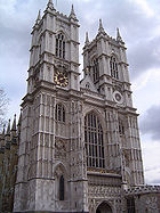
church, in the City of Westminster
, London
, United Kingdom
, located just to the west of the Palace of Westminster
. It is the traditional place of coronation
and burial site for English, later British and later still (and currently) monarchs of the Commonwealth realm
s. The abbey is a Royal Peculiar
and briefly held the status of a cathedral
from 1540 to 1550.
Westminster Abbey is a collegiate church
governed by the Dean and Chapter of Westminster
, as established by Royal charter
of Queen Elizabeth I in 1560, which created it as the Collegiate Church of St Peter Westminster and a Royal Peculiar under the personal jurisdiction of the Sovereign.
1065 Westminster Abbey is consecrated.
1066 William the Conqueror is crowned king of England, at Westminster Abbey, London.
1100 Henry I is crowned King of England in Westminster Abbey.
1154 Henry II of England is crowned at Westminster Abbey.
1189 Richard I of England (a.k.a. Richard "the Lionheart") is crowned at Westminster.
1547 Edward VI of England is crowned King of England at Westminster Abbey.
1559 Elizabeth I is crowned Queen of England in Westminster Abbey, London.
1661 King Charles II of England, Scotland and Ireland is crowned in Westminster Abbey.
1947 The Princess Elizabeth marries Lieutenant Philip Mountbatten at Westminster Abbey in London.
1950 The Stone of Scone, traditional coronation stone of British monarchs, is taken from Westminster Abbey by Scottish nationalist students. It later turns up in Scotland on April 11, 1951.

